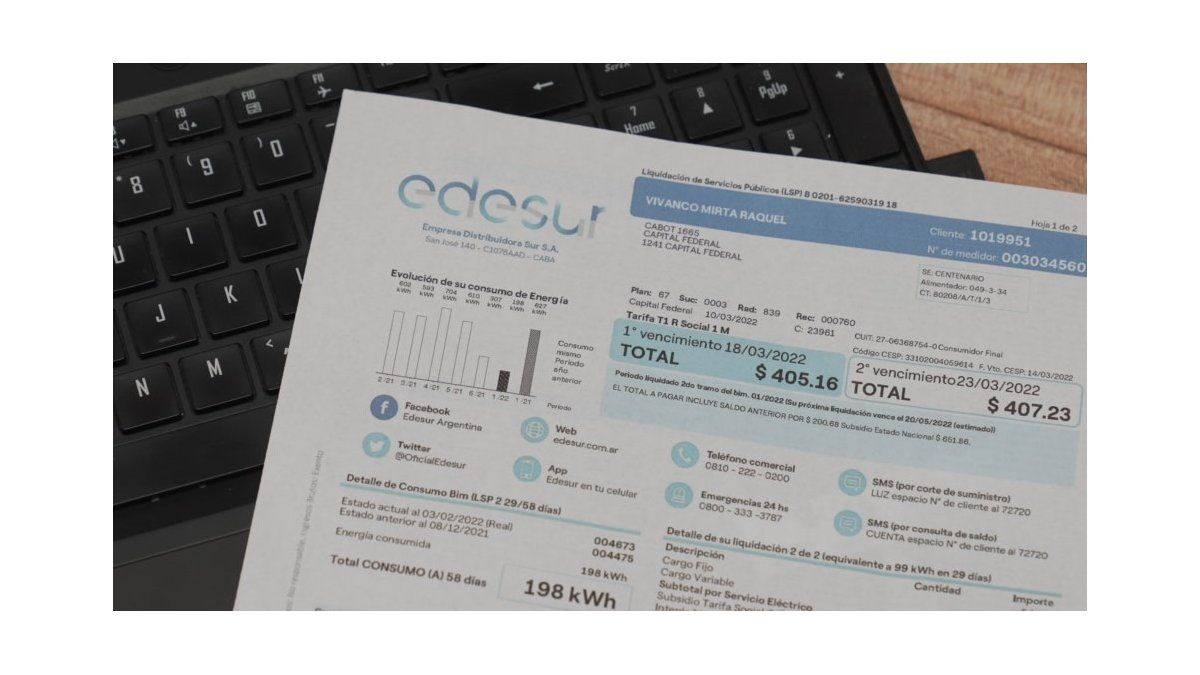Electricity bills will drop 9% starting in November. It will be for users who do not have subsidies, that is, high and middle-income families, and the industrial and commercial sector. This is how it was defined by the Ministry of Energy, which heads Flavia Royóndue to a drop in the costs of electricity generation.
As anticipated by Energy Report, this Thursday the Ministry of Economy, which conducts Sergio Massa, published in the Official Gazette resolution 884, in which the wholesale energy prices for the summer are approved, and which were raised by the company that manages the electricity market (Cammesa). The Resolution establishes the Seasonal Energy Price for the period from November to April 2024.
In practice, this means that there will be a reduction in the value of the energy price of 9%. Consequently, the bill will have a reduction of 8% starting from consumption on November 1, according to official sources.
Who is affected by the price drop?
The reduction in the electricity bill reaches those who do not have subsidies, that is, those who had been paying the full price of energy, which is why in the event of a reduction in the price of generation, it is transferred to the final bill. So, It will be felt by the so-called Large Users (consume with power > 300 kW) and the N1 residential areas, which are the families that were left out of the subsidy registry. (RASE), either because they have a high income, or because they have decided not to register.
Besides, reaches middle-income userswhich are under the figure of N3: although they have subsidies, when they exceed consumption (more than 400 KWh/month), they pay the full price for that surplus, so that is where they will see the reduction.
Reasons for the reduction in the invoice
Nicolas Gadano, an economist specialized in energy issues, explained the reasons for the drop in the price of invoices, despite the inflationary context. “Cammesa makes the programming for the next quarter and given that a devaluation of the exchange rate is not projected and there is a drop in the cost of generation, this results in a drop in the average price for users without a subsidy,” he stated.
The drop in the cost of generation is due to a strong increase in the production of hydraulic energy. “This is already happening because there is more water in the entire Comahue basin and much more is being generated compared to previous years,” Gadano explained.
The specialist specified that this energy generation is “much cheaper and, therefore, will allow savings on fuel imports,” while adding that there may be some contribution from the gas pipeline from Vaca Muerta, although of a more marginal nature for this stage. of the year.
In September, Hydrogen generation increased by 84% year-on-year. I explain 27% of the entire generation, the maximum value of the last 10 years. Last year it explained less than 20%. “That will continue because there is a lot of water and what it does is have a direct impact on costs. In September the monomic cost, which is the average electrical cost, was 66 dollars per mega watt/hour, when last year it was 87 dollars.”
No changes for low and middle income families
Despite the IMF’s requests to increase rates in its latest staff report, For the rest of the users the same prices were maintained than in the previous period (August 2023 to October 2023), so the rates remain unchanged for groups N2 and N3. These are medium and low-income families, which were included in the RASE registry. Group N2 covers beneficiaries of social tariffs and low incomes, and N3 includes middle incomes.
In addition, the resolution published in the Official Gazette adds that the benefit also covers middle-income households (N3) in the provinces of Misiones, Corrientes, Formosa, Chaco, Catamarca, Santiago del Estero, Tucumán, Salta, Jujuy, La Rioja and San Juan, always for the surplus of 650 KWh/month for the months of December 2023 to February 2023 (surplus for Level 3 Residential users) or more than 400 KWh/month for the rest of the provinces.
Macroeconomic impact
Although there will be more than 3 million users who have a reduction in their electricity bill of 8% (the N1)the measure is expected to imply a reduction in economic subsidies, which impacts fiscal accounts.
Gadano explained that “for the rest of the users the same price is maintained, but by improving cost coverage, this means that subsidies fall.” The fact is that medium and low-income users (N3 and N2) will continue to pay the same. These families pay less than 20% of what energy production costs, and the rest is subsidized by the State.
Until September, latest data available, energy subsidies fell 18.7% year-on-year in real terms (discounted for inflation) when compared to the same period of the previous year. Partly due to the implementation of tariff segmentation, The State stopped allocating almost $1 billion in subsidies (it was $892,825 million). This is clear from the latest Rates and Subsidies Report prepared by the IIEP institute, which belongs to the UBA and Conicet.
Source: Ambito




